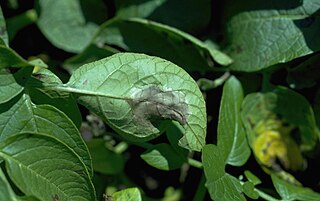
Fusarium ear blight (FEB), is a fungal disease of cereals, including wheat, barley, oats, rye and triticale. FEB is caused by a range of Fusarium fungi, which infects the heads of the crop, reducing grain yield. The disease is often associated with contamination by mycotoxins produced by the fungi already when the crop is growing in the field. The disease can cause severe economic losses as mycotoxin-contaminated grain cannot be sold for food or feed.

Phytophthora infestans is an oomycete or water mold, a fungus-like microorganism that causes the serious potato and tomato disease known as late blight or potato blight. Early blight, caused by Alternaria solani, is also often called "potato blight". Late blight was a major culprit in the 1840s European, the 1845–1852 Irish, and the 1846 Highland potato famines. The organism can also infect some other members of the Solanaceae. The pathogen is favored by moist, cool environments: sporulation is optimal at 12–18 °C (54–64 °F) in water-saturated or nearly saturated environments, and zoospore production is favored at temperatures below 15 °C (59 °F). Lesion growth rates are typically optimal at a slightly warmer temperature range of 20 to 24 °C.
Fungicides are pesticides used to kill parasitic fungi or their spores. Fungi can cause serious damage in agriculture, resulting in critical losses of yield, quality, and profit. Fungicides are used both in agriculture and to fight fungal infections in animals. Fungicides are also used to control oomycetes, which are not taxonomically/genetically fungi, although sharing similar methods of infecting plants. Fungicides can either be contact, translaminar or systemic. Contact fungicides are not taken up into the plant tissue and protect only the plant where the spray is deposited. Translaminar fungicides redistribute the fungicide from the upper, sprayed leaf surface to the lower, unsprayed surface. Systemic fungicides are taken up and redistributed through the xylem vessels. Few fungicides move to all parts of a plant. Some are locally systemic, and some move upward. Most fungicides that can be bought retail are sold in liquid form, the active ingredient being present at 0.08% in weaker concentrates, and as high as 0.5% for more potent fungicides. Fungicides in powdered form are usually around 90% sulfur.
A biopesticide is a biological substance or organism that damages, kills, or repels organisms seen as pests. Biological pest management intervention involves predatory, parasitic, or chemical relationships.

Metalaxyl is an acylalanine fungicide with systemic function. Its chemical name is methyl N-(methoxyacetyl)-N-(2,6-xylyl)-DL-alaninate. It can be used to control Pythium in a number of vegetable crops, and Phytophthora in peas. Metalaxyl-M is the ISO common name and Ridomil Gold is the trade name for the optically pure (-) / D / R active stereoisomer, which is also known as mefenoxam.

Chlorothalonil (2,4,5,6-tetrachloroisophthalonitrile) is an organic compound mainly used as a broad spectrum, nonsystemic fungicide, with other uses as a wood protectant, pesticide, acaricide, and to control mold, mildew, bacteria, algae. Chlorothalonil-containing products are sold under the names Bravo, Echo, and Daconil. It was first registered for use in the US in 1966. In 1997, the most recent year for which data are available, it was the third most used fungicide in the US, behind only sulfur and copper, with 12 million pounds used in agriculture that year. Including nonagricultural uses, the United States Environmental Protection Agency (EPA) estimates, on average, almost 15 million lb (6.8 million kg) were used annually from 1990 to 1996.

Alternaria solani is a fungal pathogen that produces a disease in tomato and potato plants called early blight. The pathogen produces distinctive "bullseye" patterned leaf spots and can also cause stem lesions and fruit rot on tomato and tuber blight on potato. Despite the name "early," foliar symptoms usually occur on older leaves. If uncontrolled, early blight can cause significant yield reductions. Primary methods of controlling this disease include preventing long periods of wetness on leaf surfaces and applying fungicides. Early blight can also be caused by Alternaria tomatophila, which is more virulent on stems and leaves of tomato plants than Alternaria solani.

Septoria malagutii is a fungal plant pathogen infecting potatoes. The casual fungal pathogen is a deuteromycete and therefore has no true sexual stage. As a result, Septoria produces pycnidia, an asexual flask shaped fruiting body, on the leaves of potato and other tuber-bearing spp. causing small black to brown necrotic lesions ranging in size from 1-5mm. The necrotic lesions can fuse together forming large necrotic areas susceptible to leaf drop, early senescence, dieback, and dwarfing. Septoria malagutii has been found only in the Andean countries of Bolivia, Ecuador, Peru, and Venezuela at altitudes of near 3000 meters. Consequently, the fungi grows and disperses best under relatively low temperatures with high humidities, with optimal growth occurring at 20 °C (68 °F). The disease has caused devastation on potato yields in South America and in areas where this disease is common, potato yields have been seen to drop by 60%.
p-Chlorocresol, or 4-chloro-3-methylphenol (ClC6H3CH3OH), also known as p-chloro-m-cresol, is a potent disinfectant and antiseptic. It appears as a pinkish white crystalline solid. It is also used as a preservative in cosmetics and medicinal products for both humans and animals. It is used as an active ingredient in some preparations of veterinary medicines for tropical, oral and parenteral use. Normally, the concentration of p-Chlorocresol in oral and parenteral veterinary products are 0.1-0.2%. Concentrations are higher (~0.5%) in tropical veterinary products. p-Chlorocresol contains microbial activity against both gram positive and gram negative bacteria and fungi.
Copper pesticides are copper compounds used as bactericides, algaecides, or fungicides. They can kill bacteria, oomycetes and algae, and prevent fungal spores from germinating. Common forms of fixed copper fungicides include copper sulfate, copper sulfate pentahydrate, copper hydroxide, copper oxychloride sulfate, cuprous oxide, and copper octanoate.

Epoxiconazole is a fungicide active ingredient from the class of azoles developed to protect crops. In particular, the substance inhibits the metabolism of fungi cells infesting useful plants, and thereby prevents the growth of the mycelia. Epoxiconazole also limits the production of conidia (mitospores). Epoxiconazole was introduced to the market by BASF SE in 1993 and can be found in many products and product mixtures targeting a large number of pathogens in various crops. Crops are, for example, cereals, soybeans, banana, rice, coffee, turnips, and red as well as sugar beets.

Novaluron, or (±)-1-[3-chloro-4-(1,1,2-trifluoro-2-trifluoro- methoxyethoxy)phenyl]-3-(2,6-difluorobenzoyl)urea, is a chemical with pesticide properties, belonging to the class of insecticides called insect growth regulators. It is a benzoylphenyl urea developed by Makhteshim-Agan Industries Ltd.. In the United States, the compound has been used on food crops, including apples, potatoes, brassicas, ornamentals, and cotton. Patents and registrations have been approved or are ongoing in several other countries throughout Europe, Asia, Africa, South America, and Australia. The US Environmental Protection Agency and the Canadian Pest Management Regulatory Agency consider novaluron to pose low risk to the environment and non-target organisms and value it as an important option for integrated pest management that should decrease reliance on organophosphorus, carbamate and pyrethroid insecticides.

Fluopicolide is a fungicide used in agriculture to control diseases caused by oomycetes such as late blight of potato. It is classed as an acylpicolide and its chemical name is 2,6-dichloro-N-{[3-chloro-5-(trifluoromethyl)pyridin-2-yl]methyl}benzamide. The precise mode of action is not known, but it is thought to act by affecting spectrin-like proteins in the cytoskeleton of oomycetes. This mode of action differs from other available fungicides used to control oomycetes and it can inhibit the growth of strains that are resistant to phenylamides, strobilurin, dimethomorph and iprovalicarb. It has some systemic activity as it moves through the xylem towards the tips of stems, but does not get transported to the roots. It affects the motility of zoospores, the germination of cysts, the growth of the mycelium and sporulation. Bayer CropScience developed the compound and it was first released as a commercial product in 2006.

Fluxapyroxad is a broad-spectrum pyrazole-carboxamide fungicide used on a large variety of commercial crops. It stunts fungus growth by inhibiting the succinate dehydrogenase (SQR) enzyme. Application of fluxapyroxad helps prevent many wilts and other fungal infections from taking hold. As with other systemic pesticides that have a long chemical half-life, there are concerns about keeping fluxapyroxad out of the groundwater, especially when combined with pyraclostrobin. There is also concern that some fungi may develop resistance to fluxapyroxad.
Buckeye rot of tomato is caused by three species of pathogens in the genus Phytophthora: P. nicotianae var. parasitica, P. capsici, and P. drechsleri. It is an oomycete that thrives in warm, wet conditions and lives in the soil. It is characterized by a bull’s eye pattern of dark brown rotting on the tomato fruit, and affects fruit that is close to, or lying on the soil. The easiest management is to keep the plant out of contact with the soil, although other chemical methods can be very effective. This disease commonly occurs in the southeast and south central areas of the United States. The disease has affected a large portion of crop yield in the United States as well as India. The relatively small genome size of Phytophthora parasitica compared to Phytophthora infestans gives researchers the unique ability to further examine its ability to cause disease.

Sedaxane is a broad spectrum fungicide used as a seed treatment in agriculture to protect crops from fungal diseases. It was first marketed by Syngenta in 2011 using their brand name Vibrance. The compound is an amide which combines a pyrazole acid with an aryl amine to give an inhibitor of succinate dehydrogenase.

Carboxin is a narrow-spectrum fungicide used as a seed treatment in agriculture to protect crops from fungal diseases. It was first marketed by Uniroyal in 1969 using their brand name Vitavax. The compound is an anilide which combines a heterocyclic acid with aniline to give an inhibitor of succinate dehydrogenase (SDHI).

Alternaria brassicicola is a fungal necrotrophic plant pathogen that causes black spot disease on a wide range of hosts, particularly in the genus of Brassica, including a number of economically important crops such as cabbage, Chinese cabbage, cauliflower, oilseeds, broccoli and canola. Although mainly known as a significant plant pathogen, it also contributes to various respiratory allergic conditions such as asthma and rhinoconjunctivitis. Despite the presence of mating genes, no sexual reproductive stage has been reported for this fungus. In terms of geography, it is most likely to be found in tropical and sub-tropical regions, but also in places with high rain and humidity such as Poland. It has also been found in Taiwan and Israel. Its main mode of propagation is vegetative. The resulting conidia reside in the soil, air and water. These spores are extremely resilient and can overwinter on crop debris and overwintering herbaceous plants.

Pydiflumetofen is a broad spectrum fungicide used in agriculture to protect crops from fungal diseases. It was first marketed by Syngenta in 2016 using their brand name Miravis. The compound is an amide which combines a pyrazole acid with a substituted phenethylamine to give an inhibitor of succinate dehydrogenase.

3-(Difluoromethyl)-1-methyl-1H-pyrazole-4-carboxylic acid is a chemical compound which is used commercially as an intermediate to seven fungicides which act by inhibition of succinate dehydrogenase (SDHI). It consists of a pyrazole ring with difluoromethyl, methyl and carboxylic acid groups attached in specific positions.














